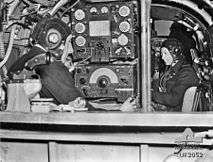Avro Lancaster
| Lancaster | |
|---|---|
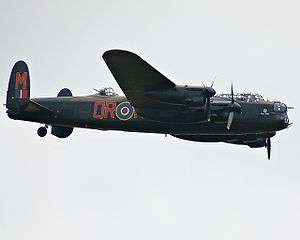 | |
| Royal Air Force Avro Lancaster B I PA474 of the Battle of Britain Memorial Flight. This aircraft carries the deepened bomb aimer's blister (Mod. 780), and the later paddle-bladed propellers. Neither H2S blister nor exhaust shrouds are fitted. | |
| Role | Heavy bomber |
| Manufacturer | Avro |
| Designer | Roy Chadwick |
| First flight | 9 January 1941 |
| Introduction | February 1942 |
| Retired | 1963 (Canada) |
| Primary users | Royal Air Force Royal Canadian Air Force Royal Australian Air Force |
| Number built | 7,377 |
| Unit cost |
£45–50,000 |
| Developed from | Avro Manchester |
| Variants | Avro Lancastrian |
| Developed into | Avro York Avro Lincoln |
The Avro Lancaster is a British four-engined Second World War heavy bomber designed and built by Avro for the Royal Air Force (RAF). It first saw active service with RAF Bomber Command in 1942 and, as the strategic bombing offensive over Europe gathered momentum, it was the central implement for the night-time bombing campaigns that followed. It became the main heavy bomber used by the RAF, the RCAF, and squadrons from other Commonwealth and European countries serving within the RAF, overshadowing its close contemporaries the Handley Page Halifax and Short Stirling.[1] The "Lanc", as it was affectionately known,[2] thus became one of the more famous and most successful of the Second World War night bombers, "delivering 608,612 long tons of bombs in 156,000 sorties."[3] The Lancaster, an evolution of the troublesome Avro Manchester, was designed by Roy Chadwick and was powered by four Rolls-Royce Merlins, or, in one version, Bristol Hercules engines.
A long, unobstructed bomb bay meant that the Lancaster could take the largest bombs used by the RAF, including the 4,000 lb (1,800 kg), 8,000 lb (3,600 kg), and 12,000 lb (5,400 kg) blockbusters, loads often supplemented with smaller bombs or incendiaries. The versatility of the Lancaster was such that it was chosen to equip 617 Squadron and was modified to carry the Upkeep "Bouncing bomb" designed by Barnes Wallis for Operation Chastise, the attack on Germany Ruhr Valley dams. Although the Lancaster was primarily a night bomber, it excelled in many other roles, including daylight precision bombing: in the latter role some Lancasters were adapted to carry the 12,000 lb (5,400 kg) Tallboy and then the 22,000 lb (10,000 kg) Grand Slam earthquake bombs (also designed by Wallis).[4]
In 1943, a Lancaster was converted to become an engine test bed for the Metropolitan-Vickers F.2 turbojet. Lancasters were later used to test other engines, including the Armstrong Siddeley Mamba and Rolls-Royce Dart turboprops, and the Avro Canada Orenda and STAL Dovern turbojets. Postwar, the Lancaster was supplanted as the RAF's main strategic bomber by the Avro Lincoln, a larger version of the Lancaster. The Lancaster took on the role of long range anti-submarine patrol aircraft (later supplanted by the Avro Shackleton) and air-sea rescue. It was also used for photo-reconnaissance and aerial mapping, as a flying tanker for aerial refuelling and as the Avro Lancastrian, a long-range, high-speed, transatlantic, passenger and postal delivery airliner. In March 1946, a Lancastrian of BSAA flew the first scheduled flight from the new London Heathrow Airport.[5]
Development
The origins of the Lancaster stem from a twin-engined bomber design submitted to meet Air Ministry Specification P.13/36, which was for a new generation of twin-engined medium bombers for "worldwide use", the engine specified as the Rolls-Royce Vulture.[6] The resulting aircraft was the Manchester, which, although a capable aircraft, was underpowered and troubled by the unreliability of the Vulture engine. Only 200 Manchesters were built, with the type withdrawn from service in 1942.[7]
Avro's chief design engineer, Roy Chadwick, was already working on an improved Manchester design using four of the more reliable but less powerful Rolls-Royce Merlin engines, in the form of Merlin "Power Plant" installations developed by Rolls-Royce for the Beaufighter II,[8] installed on a larger wing. At first the aircraft was called Avro Type 683 Manchester III and later renamed the Lancaster. The prototype aircraft BT308 was assembled by the Avro experimental flight department at Ringway Airport, Manchester. Test pilot H. A. "Bill" Thorn took the controls for its first flight at Ringway, on Thursday, 9 January 1941. The aircraft proved to be a great improvement on its predecessor, being "one of the few warplanes in history to be 'right' from the start."[9] Its initial three-finned tail layout, a result of the design being adapted from the Manchester I, was quickly changed on the second prototype DG595 and subsequent production aircraft, to the familiar twin-finned specification also used on the later Manchesters.
Some of the later orders for Manchesters were changed in favour of Lancasters; the designs were very similar and both featured the same distinctive greenhouse cockpit, turret nose and twin tail. The Lancaster discarded the stubby central third tail fin of the early Manchesters and used the wider span tailplane and larger elliptical twin fins from the later Manchester IA.
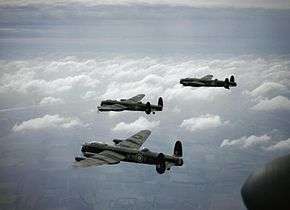
The majority of Lancasters built during the war years were manufactured by Avro at their factory at Chadderton near Oldham, Greater Manchester and test flown from Woodford Aerodrome in Cheshire. Other Lancasters were built by Metropolitan-Vickers (1,080, also tested at Woodford) and Armstrong Whitworth. It was also produced at the Austin Motor Company works in Longbridge, Birmingham, later in the Second World War and postwar by Vickers-Armstrongs at Chester as well as at the Vickers Armstrong factory, Castle Bromwich, Birmingham. Only 300 of the Lancaster B II fitted with Bristol Hercules engines were constructed; this was a stopgap modification caused by a shortage of Merlin engines as fighter production was of higher priority. The Lancaster B III had Packard Merlin engines but was otherwise identical to contemporary B Is, with 3,030 B IIIs built, almost all at Avro's Newton Heath factory. The B I and B III were built concurrently and minor modifications were made to both marks as new batches were ordered. Examples of these modifications were the relocation of the pitot head from the nose to the side of the cockpit and the change from de Havilland "needle blade" propellers to Hamilton Standard or Nash Kelvinator made "paddle blade" propellers.[10]
Of later variants, only the Canadian-built Lancaster B X, manufactured by Victory Aircraft in Malton, Ontario, was produced in significant numbers. A total of 430 of this type were built, earlier examples differing little from their British-built predecessors, except for using Packard-built Merlin engines and American-style instruments and electrics. The first Lancaster produced in Canada was named the "Ruhr Express".[Note 1] The first batch of Canadian Lancasters delivered to England suffered from faulty ailerons. This was traced to the use of unskilled labourers.[11]
Design
Overview
The Lancaster is a mid-wing cantilever monoplane with an oval all-metal fuselage. The wing was constructed in five main sections, the fuselage in five sections. All wing and fuselage sections were built separately and fitted with all the required equipment before final assembly. The tail unit had twin elliptical fins and rudders. The Lancaster was initially powered by four wing-mounted Rolls-Royce Merlin piston engines driving 13 ft diameter de Havilland Hydromatic three-bladed airscrews. It had retractable main landing gear and fixed tailwheel, with the hydraulically operated main landing gear raising rearwards into the inner engine nacelles.[12]
Crew accommodation
Starting at the nose, the bomb aimer had two positions to man. His primary location was lying prone on the floor of the nose of the aircraft, with access to the bombsight controls facing forward, with the bombsight computer on his left and bomb release selectors on the right. He also used his view out of the large transparent perspex nose cupola to assist the navigator with map reading. To man the Frazer Nash FN5 nose turret, he stood up placing himself in position behind the triggers of the twin .303 in (7.7 mm) guns. Ammunition for the turret was 1,000 rounds per gun (rpg). The bomb aimer's position contained the nose emergency hatch in the floor; at 22 inches by 26.5 inches (two inches narrower than the Halifax escape hatch) it was difficult to exit through while wearing a parachute. Compared with other contemporary aircraft, the Lancaster was not an easy aircraft to escape from; in a Halifax, 25% of downed aircrew bailed out successfully, and in American bombers (albeit in daylight raids) it was as high as a 50% success rate while only 15% of the Lancaster crew were able to bail out.[13] Operational research experts (Freeman Dyson, amongst others) attempted unsuccessfully to have the escape hatch enlarged.
On the roof of the bomb bay the pilot and flight engineer sat side by side under the expansive canopy, with the pilot sitting on the left on a raised portion of the floor (almost all British bombers, and most German bombers, had only a single pilot seat as opposed to American practice of carrying two pilots, or at least having controls for two pilots installed). The flight engineer sat on a collapsible seat (known as a "second dicky seat") to the pilot's right, with the fuel selectors and gauges on a panel behind him and to his right. The pilot and other crew members could use the panel above the cockpit as an auxiliary emergency exit while the mid-upper gunner was expected to use the rear entrance door to leave the aircraft. The tail gunner escaped by rotating his turret to the rear, opening the door in the back of the turret, passing into the fuselage, and clipping on a parachute that was hung on the side wall. He could then exit through the rear entrance door.[14]
Behind the pilot and flight engineer, and behind a curtain fitted to allow him to use light to work, sat the navigator. His position faced to port with a chart table in front of him. An instrument panel showing the airspeed, altitude, and other information required for navigation was mounted on the side of the fuselage above the chart table.
The wireless operator's radios were mounted on the left-hand end of the chart table, facing the rear of the aircraft. Behind these and facing forwards the wireless operator sat on a seat at the front of the main spar. On his left was a window, and above him was the astrodome, used for visual signalling and by the navigator for celestial navigation.
Behind the wireless operator were the two spars for the wing, which created a major obstacle for crew members moving down the fuselage even on the ground. On reaching the end of the bomb bay the floor dropped down to the bottom of the fuselage, and the mid-upper gunner's turret was reached. His position allowed a 360° view over the top of the aircraft, with two Browning .303 Mark IIs to protect the aircraft from above and to the side. The mid-upper gunner sat on a rectangle of canvas that was slung beneath the turret and would stay in position throughout the flight. Ammunition for the turret was 1,000 rounds per gun.
To the rear of the turret was the side crew door, on the starboard side of the fuselage. This was the main entrance to the aircraft, and also could be used as an emergency exit. The Elsan chemical toilet, a type of aircraft lavatory, was located near the spars for the tailplane. At the extreme tail-end of the fuselage, the rear gunner sat in his exposed position in the tail turret, which was entered through a small hatch in the rear of the fuselage. Depending on the size of the rear gunner, the area was so cramped that the gunner would often hang his parachute on a hook inside the fuselage, near the turret doors. Neither the mid-upper nor the rear gunner's position was heated, and the gunners had to wear electrically heated suits to prevent hypothermia and frostbite. Many rear gunners insisted on having the centre section of perspex removed from the turret to improve visibility. The transparencies were difficult to see through at night, particularly when trying to keep watch for enemy night fighters that appeared without notice astern and below the aircraft when getting into position to open fire. This removal of perspex from the turret was called the "Gransden Lodge" modification. Ammunition for the tail turret was 2,500 rounds-per-gun. Due to the weight, the ammunition was stored in tanks situated near the mid-upper turret's position and fed rearward in runways down the back of the fuselage to the turret.[15]
Armament
Defensive armament

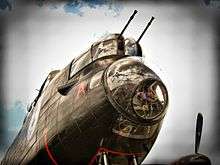
The Avro Lancaster was initially equipped with four Nash & Thomson Frazer Nash hydraulically operated turrets mounted in the nose, tail, mid-upper and underside. The original tail turret was equipped with four Browning .303 Mark II machine guns and all other turrets with two such machine guns.[16][17]
Nose turret
Only the FN-5A[16] nose turret which was similar to the FN-5 used on the preceding Avro Manchester, the Vickers Wellington and the Short Stirling remained unchanged during the life of the design, except in instances where it was removed entirely.
Ventral turret
The ventral (underside) FN-64 turret quickly proved to be dead weight, being both difficult to sight because it relied on a periscope which limited the gunner's view to a 20 degree arc,[16] and too slow to keep a target within its sights.[Note 2] Aside from early B Is and the prototype B IIs, the FN-64 was almost never used. When the Luftwaffe began using Schräge Musik to make attacks from below in the winter of 1943/1944, modifications were made, including downward observation blisters mounted behind the bomb aimer's blister[18] and official[19] and unofficial mounts for .50 in (12.7 mm) machine guns or even 20 mm cannon, firing through the ventral holes of the removed FN-64. The fitting of these guns was hampered as the same ventral position was used for mounting the H2S blister, which limited installations to those aircraft fitted with bulged bomb bays which interfered with the H2S.[16]
Mid-upper turret
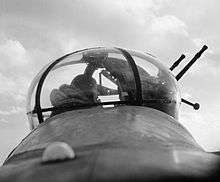
The mid-upper (dorsal or top) turret was an FN-50[16][17] on early examples and the very similar FN-150 with improved sights and controls[16] on later examples. On all but the earliest examples this turret was surrounded by a coaming which provided a track for a cam operated interruptor device which prevented the gunner from shooting the tail of his own aircraft.[16] The Mk. VII and late Mk. X Lancasters used the heavier, electrically controlled Martin 250 CE 23A turret equipped with two .50 inch machine guns[16] which was mounted further forward to preserve the aircraft's longitudinal balance, and because it had an internal mechanism to prevent firing on the aircraft itself, it did not require a coaming.[Note 3][16] Other experimental turrets were tried out, including the FN-79 and the Boulton-Paul Type H barbette system.[16]
Tail turret
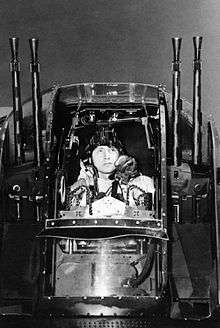
The tail turret was the most important defensive position and carried the heaviest armament. Despite this, the turrets used, starting with the FN-20, were never entirely satisfactory and numerous designs were tried. The FN-20 was replaced by the very similar FN-120 which used an improved gyroscopic gun sight (GGS).[16] Gunners using both the FN-20 and 120 removed perspex and armour from the turret to improve visibility, but trials by the RAF showed that a Mosquito night fighter was still able to get within a very short distance of the tail gunner without being spotted, confirming what the Luftwaffe had already realised. The Rose turret attempted to improve on the FN turrets by being completely open to the rear (improving visibility and allowing easier emergency egress) and by being fitted with two .50 inch machine guns and was installed in a small number of Lancasters but never became common.[16] Ultimately radar, rather than improved visibility, made the turret more effective. The FN-121 was the Automatic Gun Laying Turret (AGLT), an FN-120 fitted with Village Inn gun-laying radar.[16] Aircraft fitted with Village Inn were used as bait, flying behind the main formations to confront the night fighters that followed the formations and shot down stragglers. This significantly reduced operational losses; and gun-laying radar was added to the last versions of the turret. Before the end of the war Lancasters built in the UK standardised on the FN-82 fitted with two .50 inch machine guns and fitted with gun-laying radar as production allowed, which was also used on early models of the Avro Lincoln. The disadvantage of all radar and radio transmitting systems is that attacking forces can locate aircraft by picking up transmissions.
Later in the war Freeman Dyson made a case for removing all the Lancaster's defensive armament, arguing it would reduce the loss rate by increasing the Lancaster's speed by up to 50 mph (assuming the bomb load was not increased at the same time), and thus make it harder to shoot down. This became even more important when Dyson and Mike O'Loughlin concluded that some of the German night fighters were using Schräge Musik upward firing guns, as the Lancaster had no ventral gun turret to defend itself, although any defence would depend on the crew detecting the attack from underneath.[20] Dyson considered that the modification would be justified even if the aircraft loss rate was unchanged, as two defensive air gunners would not be required, reducing human losses. The case for speed over defensive armament was supported by the Mosquito, whose loss rates were far lower than the Lancaster's. As an example, during the Battle of Berlin (18 November 1943 to 30 March 1944) the average loss rate of the heavy bombers (overwhelmingly Lancasters) was 5.1%, whereas for Mosquitoes it was 0.5%,[21] though a speed-optimised Lancaster would still be up to 50 mph slower than a Mosquito and unlikely to match its low loss rates.
Bombs
An important feature of the Lancaster was its unobstructed 33 ft (10 m) long bomb bay. At first, the heaviest bomb carried was the 4,000 lb (1,800 kg) high capacity HC "Cookie".[23] Bulged doors were added to 30% of B Is to allow the aircraft to carry 8,000 lb (3,600 kg) and later 12,000 lb (5,400 kg) "Cookies". The Lancaster also carried a variety of smaller weapons, including the Small Bomb Container (SBC) which held 236 4 lb (1.8 kg) or 24 30 lb (14 kg) incendiary and explosive incendiary bomblets; 500 lb (230 kg) and 1,000 lb (450 kg) General Purpose High Explosive (GP/HE) bombs (these came in a variety of designs); 1,850 lb (840 kg) parachute deployed magnetic or acoustic mines, or 2,000 lb (910 kg) armour-piercing (AP) bombs; 250 lb (110 kg) Semi-Armour-Piercing (SAP) bombs, used up to 1942 against submarines; post 1942: 250 lb (110 kg) or 500 lb (230 kg) anti-submarine depth charges.
In 1943, 617 Squadron was created to carry out Operation Chastise, the raid against the Ruhr dams. This unit was equipped with B.III (Specials), officially designated the "Type 464 (Provisioning)", modified to carry the 9,250 lb (4,200 kg) "Upkeep" bouncing bomb.[24] [Note 4]. The bomb bay doors were removed and the ends of the bomb bay were covered with fairings. "Upkeep" was suspended on laterally pivoted, vee-shaped struts which sprang apart beamwise when the bomb-release button was pressed. A drive belt and pulley to rotate the bomb at 500 rpm was mounted on the starboard strut and driven by a hydraulic motor housed in the forward fairing. The mid-upper turret was removed and a more bulbous bomb aimer's blister was fitted; this, as "Mod. 780", later becoming standard on all Lancasters, while the bombsight was replaced by a simple aiming device.[25] Two Aldis lights were fitted in the rear bomb bay fairing; the optimum height for dropping "Upkeep" was 60 ft and, when shone on the relatively smooth waters of the dam's reservoirs, the light beams converged into a single spot when the Lancaster was flying at the correct height.[26]
Towards the end of the war, attacking special and hardened targets, other variants of B I Specials were modified to carry the 21 ft (6.4 m) long 12,000 lb (5,400 kg) "Tallboy" or 25.5 ft (7.8 m) long 22,000 lb (10,000 kg) "Grand Slam" "earthquake" bombs. Aircraft intended to carry the "Grand Slam" required extensive modifications. These included the removal of the dorsal turret and of two guns from the rear turret, removal of the cockpit armour plating (the pilot's seatback), and installation of Rolls-Royce Merlin Mk 24 engines for better take-off performance. The bomb bay doors were removed and the rear end of the bomb bay cut away to clear the tail of the bomb. Later the nose turret was also removed to further improve performance. A strengthened undercarriage and stronger mainwheels, later used by the Avro Lincoln, were fitted.[4][27]
Specific bomb loads were standardised and given code names by Bomber Command:[28]


| Codename | Type of raid or target | Bomb load |
|---|---|---|
| "Arson" | incendiary area bombing | 14 SBC, each with 236 x 4 lb Incendiary and Explosive Incendiary bomblets, total 3,304. |
| "Abnormal" | factories, railway yards, dockyards | 14 x 1,000 lb GP/HE bombs using both impact and long delay (up to 144 hours) fuses. |
| "Cookie"—or—"Plumduff" | Blast, demolition and fire | 1 x 4,000 lb impact-fused HC bomb. 3 x 1,000 lb GP/HE bombs, and up to 6 SBCs with 1,416 incendiary bomblets. |
| "Gardening" | Mining of ports, canals, rivers and seaways | 6 x 1,850 lb parachute mines. |
| "No-Ball" | V-1 flying bomb launch sites | 1 x 4,000 lb impact fused HC and up to 18 x 500 lb GP bombs, with both impact and delay fusing. |
| "Piece" | Docks, fortifications and ships | 6 x 2,000 lb short-delay fused AP bombs, plus other GP/HE bombs based on local needs or availability. |
| "Plumduff-Plus" | Heavy industry | 1 x 8,000 lb impact or barometric fused HC and up to 6 x 500 lbs impact or delay fused GP/HE bombs. |
| "Usual" | Blast and incendiary area bombing | 1 x 4,000 lb impact-fused HC bomb, and 12 SBCs with a total of 2,832 incendiary bomblets. |
| no code name given | Medium-range low altitude tactical raids | 6 x 1,000 lb short and long delay fused GP/HE bombs, additional 250 lb GP/HE bombs sometimes added. |
| no code name given | Submarines | (up to 1942): 5 x 250 lb short delay fuse SAP bombs for surfaced U-boats; (post-1942): 6 x 500 lb and 3 x 250 lb anti-submarine depth charge bombs. |
| Special purpose weapons and codenames | Type of target | Weapon |
|---|---|---|
| "Grand Slam" | Underground or armoured facilities | 1 x 22,000 lb short-delay fused "Grand Slam" bomb. |
| "Tallboy" | Very strong or durable structures (e.g.: submarine pens); battleship Tirpitz | 1 x 12,000 lb short-delay fused "Tallboy" bomb. |
| "Upkeep" | Dams | 1 x 9,250 lb, hydrostatic-fused "Upkeep" mine. |
Bombsights
Bombsights used on Lancasters included:[29]
- Mark IX Course Setting Bomb Sight (CSBS).
- This was an early preset vector bombsight that involved squinting through wires that had to be manually set based on aircraft speed, altitude and bombload. This sight lacked tactical flexibility as it had to be manually adjusted if any of the parameters changed and was soon changed in favour of more advanced designs.
- Mark XIV bombsight
- A vector bombsight where the bomb aimer input details of the bombload, target altitude and wind direction and the analogue computer then continuously calculated the trajectory of the bombs and projected an inverted sword shape onto a sighting glass on the sighting head. Assuming the sight was set correctly, when the target was in the cross hairs of the sword shape, the bomb aimer would be able to accurately release the bombs.
- T1 bombsight
- A Mark XIV bombsight modified for mass production and produced in the USA. Some of the pneumatic gyro drives on the Mk XIV sight were replaced with electronic gyros and other minor modifications were made.
- Stabilizing Automatic Bomb Sight
- Also known as "SABS", this was an advanced bombsight mainly used by 617 Squadron for precision raids. Like the American Norden bombsight it was a tachometric sight.
Radio, radar and countermeasures equipment
The Lancaster had a very advanced communications system for its time. Most British-built Lancasters were fitted with the R1155 receiver and T1154 transmitter, whereas the Canadian-built aircraft and those built for service in the Far East had American radios. These provided radio direction-finding, as well as voice and Morse capabilities.
- H2S
- 3 GHz frequency, ground-looking navigation radar system – eventually, it could be homed in on by the German night fighters' FuG 350 Naxos receiver and had to be used with discretion — a problem which the higher resolution, 10 GHz frequency American H2X radar never had to deal with. This is the large blister under the rear fuselage on later Lancasters.
- Fishpond
- An add-on to H2S that provided additional (aerial) coverage of the underside of the aircraft to display attacking fighters on an auxiliary screen in the radio operator's position.
- Monica
- A rearward-looking radar to warn of night fighter approaches. However, it could not distinguish between attacking enemy fighters and nearby friendly bombers and served as a homing beacon for suitably equipped German night fighters. Once this was realised, it was removed altogether.
- GEE
- A receiver for a navigation system of synchronised pulses transmitted from the UK – aircraft calculated their position from the time delay between pulses. The range of GEE was 3–400 mi (483–644 km). GEE used a whip aerial mounted on the top of the fuselage ahead of the mid-upper turret.
- Boozer (radar detector)
- A system of lights mounted on the aircraft's instrument panel that lit up when the aircraft was being tracked by the low-UHF band Würzburg-Riese ground radar and early model Lichtenstein B/C and C-1 airborne radar. In practice it was found to be more disconcerting than useful, as the lights were often triggered by false alerts in the radar-signal-infested skies over Germany.
- Oboe
- A very accurate navigation system consisting of a receiver/transponder for two radar stations transmitting from widely separated locations in Southern England which, when used together, determined the aircraft's position. The system could only handle one aircraft at a time, and was fitted to a Pathfinder aircraft, usually a fast and manoeuvrable Mosquito which marked the target for the main force rather than a Lancaster.
- GEE-H
- Similar to Oboe but with the transponder on the ground allowing more aircraft to use the system simultaneously. GEE-H aircraft were usually marked with two horizontal yellow stripes on the fins.
- "Village Inn" Automatic Gun-Laying Turret
- A radar-aimed and ranged gun turret fitted to some Lancaster rear turrets in 1944. Identifiable by a radome mounted below the turret.
- Airborne Cigar (ABC)
- This was only fitted to the Lancasters of 101 Squadron. It had three 7-foot (2.1 m) aerials, two sticking out of the top of the fuselage and one under the bomb aimer's position. These aircraft carried a German-speaking crew member and were used to jam ground-to-air communications to German night fighters. The extra equipment and extra crewman added around 600 pounds (272 kg) to the bomber's weight so the bomb load was reduced by 1,000 pounds (454 kg).[30] Due to the nature of the equipment, the enemy was able to track the aircraft and 101 Squadron suffered the highest casualty rate of any squadron. Fitted from about mid-1943, they remained until the end of the war.
- Tinsel
- A microphone installed in the nacelle of one of the engines that allowed the wireless operator to transmit engine noise on the German night fighter control voice frequencies.
Operational history
Second World War

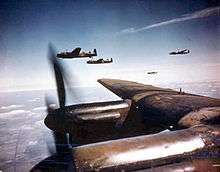

The first RAF squadron to convert to the Lancaster was No. 44 Squadron RAF in early 1942.
Lancasters flew 156,000 sorties and dropped 608,612 long tons (618,378 tonnes) of bombs between 1942 and 1945. Lancasters were the mainstay of British heavy bombers from 1942 until the introduction of the Lincoln in large numbers, post-Second World War. Just 35 Lancasters completed more than 100 successful operations each, and 3,249 were lost in action. The most successful survivor completed 139 operations, and was scrapped in 1947.
Lancasters took part in the devastating round-the-clock raids on Hamburg during Air Chief Marshal Harris's "Operation Gomorrah" in July 1943. A famous Lancaster bombing raid was the 1943 mission, codenamed Operation Chastise, to destroy the dams of the Ruhr Valley. The operation was carried out by 617 Squadron in modified Mk IIIs carrying special drum-shaped bouncing bombs designed by Barnes Wallis. The story of the operation was later made into a film, The Dam Busters. Also famous was a series of Lancaster attacks using Tallboy bombs against the German battleship Tirpitz, which first disabled and later sank the ship.
Adolf Galland (commander of the Luftwaffe fighters) considered the Lancaster to be "the best night bomber of the war",[31] as did his adversary, Arthur "Bomber" Harris, who referred to it as the RAF Bomber Command's "shining sword".[32]
Lancasters from Bomber Command were to have formed the main strength of Tiger Force, the Commonwealth bomber contingent scheduled to take part in Operation Downfall, the codename for the planned invasion of Japan in late 1945. Together with the new Avro Lincoln and Liberators they would have operated from bases on Okinawa; the invasion was made unnecessary by the Japanese surrender.
RAF Lancasters dropped food into the Holland region of the occupied Netherlands, with the acquiescence of the occupying German forces, to feed people who were in danger of starvation. The mission was named 'Operation Manna' after the food manna which is said to have miraculously appeared for the Israelites in the Book of Exodus. The aircraft involved were from 1, 3, and 8 Groups, and consisted of 145 Mosquitos and 3,156 Lancasters, flying between them a total of 3,298 sorties. The first of the two RAF Lancasters chosen for the test flight was nicknamed "Bad Penny" from the old expression: "a bad penny always turns up." This bomber, with a crew of seven men (five Canadians including pilot Robert Upcott of Windsor, Ontario), took off in bad weather on the morning of 29 April 1945 without a ceasefire agreement from the German forces, and successfully dropped its cargo. A development of the Lancaster was the Avro Lincoln bomber, initially known as the Lancaster IV and Lancaster V. These two marks became the Lincoln B1 and B2 respectively. A civilian airliner was based on the Lancaster, the Lancastrian. Other developments were the York, a square-bodied transport and, via the Lincoln, the Shackleton which continued in airborne early warning service up to 1992.
Postwar
In June 1947, the Argentine Air Force received 15 Lancasters. During its Argentine service, Lancasters saw limited use in military coups, owing to the small number there.
A total of 59 Lancaster B.Is and B.VIIs were overhauled by Avro at Woodford and Langar and delivered to the Aeronavale (France) during 1952/53. These were flown until the mid-1960s by four squadrons in France and New Caledonia in the maritime reconnaissance and search-and-rescue roles.[33]

Beginning in 1946, Lancaster Mk Xs were modified for service with the Royal Canadian Air Force. Fourteen were modified for aerial and photo-reconnaissance work and performed much of the mapping of northern Canada until as late as 1962. Throughout the 1950s the RCAF operated seventy modified Lancasters, designated Lancaster 10MR/MPs, as Maritime Reconnaissance and Patrol aircraft in an anti-submarine role. Modifications involved the installation of radar and sonobuoy operators' positions, removal of the rear and mid-upper gun turrets, installation of a 400-gallon fuel tank in the bomb bay to increase the patrol range, upgraded electronics, radar, and instrumentation, and a cooking stove in the centre section.[34] They served throughout the 1950s, when they were replaced by the Lockheed Neptune and Canadair Argus.[35]
Civil conversions continued postwar. In 1946, four Lancasters were converted by Avro at Bracebridge Heath, Lincolnshire as freighters for use by British South American Airways, but proved to be uneconomical, and were withdrawn after a year in service. In addition, four Lancaster IIIs were converted by Flight Refuelling Limited as two pairs of tanker and receiver aircraft for development of in-flight refuelling. In 1947, one aircraft was flown non-stop 3,459 mi (5,567 km) from London to Bermuda. Later the two tanker aircraft were joined by another converted Lancaster and used in the Berlin Airlift, achieving 757 tanker sorties.
From 1943 to 1947 the Canadian Government Trans-Atlantic Air Service (CGTAS) provided a trans-Atlantic military passenger and postal delivery service using a modified long-distance transport version of the Lancaster Mark X. Nine of these aircraft were produced, referred to as Lancaster XPPs (for Lancaster Mk.X Passenger Planes), and each was equipped with rudimentary passenger facilities. The inaugural flight from Dorval (Montreal) to Prestwick, Scotland on 22 July 1943, was completed non-stop in a record 12:26 hours; the average crossing time was about 13:25 hours. By the end of the war, these aircraft had completed hundreds of trips across the Atlantic. CGTAS ushered in the era of commercial air travel across the North Atlantic, and in 1947 the service became part of Trans-Canada Air Lines, which carried paying civilian passengers in the Lancaster XPPs until they were replaced by Douglas DC-4s in 1947.[35][36][37]
Variants
- B.I
![]() Media related to Avro Lancaster B Mark I at Wikimedia Commons
Media related to Avro Lancaster B Mark I at Wikimedia Commons
- The original Lancasters were produced with Rolls-Royce Merlin XX engines and SU carburettors. Minor details were changed throughout the production series – for example the pitot head design was changed from being on a long mast at the front of the nose to a short fairing mounted on the side of the fuselage under the cockpit. Later production Lancasters had Merlin 22 and 24 engines. No designation change was made to denote these alterations.[38]
- B.I Special
![]() Media related to Avro Lancaster B I Special at Wikimedia Commons
Media related to Avro Lancaster B I Special at Wikimedia Commons
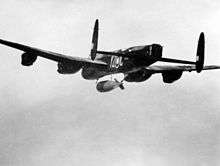
- 32 Aircraft were adapted to take first the super-heavy "Tallboy" and then "Grand Slam" bombs. Up-rated engines with paddle-bladed propellers gave more power, and the removal of gun turrets reduced weight and gave smoother lines. For the Tallboy, the bomb bay doors were bulged; for the Grand Slam, they were removed completely and the area faired over. For some Tallboy raids, the mid-upper turret was removed. This modification was retained for the Grand Slam aircraft, and in addition the nose turret was later removed. Two airframes (HK541 and SW244) were modified to carry a dorsal "saddle tank" with 1,200 gal (5,455 L) mounted aft of a modified canopy for increasing range. No. 1577 SD Flight tested the aircraft in India and Australia in 1945 for possible use in the Pacific,[17] but the tank adversely affected handling characteristics when full and an early type of in-flight refuelling designed in the late 1930s for commercial flying boats was later used instead.[39]
- PR.1
- B 1 modified for photographic reconnaissance, operated by RAF No. 82 and No. 541 Squadrons, wartime. All armament and turrets were removed with a reconfigured nose and a camera carried in the bomb bay. The type was also operated by 683 Squadron from circa 1950 for photographic reconnaissance based at Aden and subsequently Habbaniya in Iraq until disbanded 30 November 1953.
- B.I (FE)
- In anticipation of the needs of the Tiger Force operations against the Japanese in the Far East (FE), a tropicalised variant was based on late production aircraft. The B I (FE) had modified radio, radar, navaids, and a 400 gal (1,818 L) tank installed in the bomb bay. Most were painted with white upper-surfaces to reduce internal temperatures in the tropical sun, and black undersides with a low demarcation between the colours, completely omitting any red colours on the national insignia in all cases to avoid confusion with the hinomaru insignia of the Japanese.
- B.II
![]() Media related to Avro Lancaster B Mark II at Wikimedia Commons
Media related to Avro Lancaster B Mark II at Wikimedia Commons

- Bristol Hercules (Hercules VI or XVI engines) powered variant, of which 300 were produced by Armstrong Whitworth. One difference between the two engine versions was that the VI had manual mixture control, requiring an extra lever on the throttle pedestal. Very early examples were fitted with an FN.64 ventral turret; however, these were quickly removed due to problems with aiming the turret through its periscope (which prevented the gunner from seeing a target he was not already aiming at), and inadequate traverse speed.
- Due to the Luftwaffe Schräge Musik attacks, a variety of unofficial field modifications were made, including fitting of 20 mm cannon or a .50 inch machine gun in the open hole where the FN.64 had been installed, before an official modification (Mod 925) fitted with a .303 inch machine gun was authorised for the same location, though not in all aircraft. These were rarely installed on other variants as the H2S radar that was not used on the B II was mounted there. Three types of bulged bomb bay were used on the B II, the prototype having a narrow bulge running from just aft of the cockpit to the end of the bomb bay, while early production examples had a full width bulge that ran the same length and on late production examples the bomb bay doors were prominently bulged throughout their length.
- B.III
![]() Media related to Avro Lancaster B Mark III at Wikimedia Commons
Media related to Avro Lancaster B Mark III at Wikimedia Commons
- This variant, which was built concurrently with the B I and was indistinguishable externally from that variant, was fitted with Packard-built Merlin engines. The Packard Merlins used Bendix – Stromberg pressure-injection carburettors, requiring the addition of slow-running cut-off switches in the cockpit.
- B III (Special)
![]() Media related to Avro Lancaster B III Special at Wikimedia Commons
Media related to Avro Lancaster B III Special at Wikimedia Commons

- Known at the time of modification as the "Type 464 Provisioning"[40] Lancaster, 23 aircraft of this type were built to carry the "Upkeep" bouncing bomb for the dam busting raids. The bomb bay doors were removed and Vickers-built struts to carry the bomb were fitted in their place at Woodford Aerodrome near Stockport where the workers worked day and night. A hydraulic motor, driven by the pump previously used for the mid-upper turret was fitted to spin the bomb. Lamps were fitted in the bomb bay and nose for the simple height measurement system which enabled the accurate control of low-flying altitude at night. The mid-upper turret was removed to save weight and the gunner moved to the front turret to relieve the bomb aimer from having to man the front guns so that he could assist with map reading.
- ASR.III/ASR.3
- B III modified for air-sea rescue, with three dipole ventral antennas fitted aft of the radome and carrying an airborne lifeboat in an adapted bomb bay. The armament was often removed and the mid-upper turret faired-over, especially in postwar use. Observation windows were added to both sides of the rear fuselage, a port window just forward of the tailplane and a starboard window into the rear access door. A number of ASR 3 conversions were fitted with Lincoln-style rudders.[41]
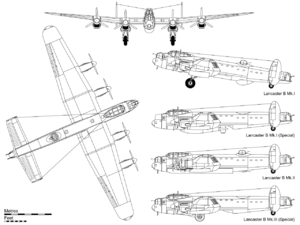
- GR.3/MR.3
- B.III modified for maritime reconnaissance.
- B.IV
- The B.IV featured an increased wingspan and lengthened fuselage and new Boulton Paul F turret (two X 0.5in Browning machine guns) with framed "bay window" nose glazing. The prototypes (PW925, PW929 and PW932) were powered by two-stage Merlin 85s inboard and later, Merlin 68s on the outboard mounts. Because of the major redesign, the aircraft was quickly renamed Lincoln B 1.
- B.V
- Increased wingspan and lengthened fuselage, two-stage Merlin 85s. Renamed Lincoln B 2
- B.VI
- Nine aircraft converted from B.IIIs. Fitted with Merlin 85/87 which had two-stage superchargers, giving much improved high altitude performance. The B VI could achieve a maximum speed of 313 mph (505 km/h) at 18,200 ft (5,550 m) at 65,000 lb (29,500 kg) take off weight and a service ceiling of 28,500 ft (8,690 m) at the same weight. Climb to 28,000 ft (8,500 m) at 65,000 lb (29,500 kg) take off weight was accomplished in 44.8 minutes with a maximum climb rate of 1,080 ft/min (5.5 m/s) at 1,000 ft (305 m).[42] A Lancaster B VI was dived to a maximum indicated speed of 350 mph (565 km/h), or Mach 0.72 at 25,000 ft (7,620 m) in June 1944.[43] The Merlin 85/87 series engines were fitted with annular cowlings similar to the Avro Lincoln and three bladed paddle-type propellers were fitted. These aircraft were only used by Pathfinder units; by No. 7 Squadron RAF, No. 83 Squadron RAF, No. 405 Squadron RCAF and by No. 635 Squadron RAF. Often used as a "Master Bomber" the B VI's were allocated to RAF Bomber Command apart from two that were retained by Rolls-Royce for installation and flight testing.[44] Their dorsal and nose turrets were removed and faired-over. The more powerful engines proved troublesome in service and were disliked by ground maintenance staff for their rough running and propensity to 'surge and hunt', making synchronisation impossible. This was caused by variations in the fuel/air mixture and over time would damage the engine.[45] The B VI was withdrawn from operational service in November 1944 and surviving aircraft were used by Rolls-Royce, the Royal Aircraft Establishment and the Bomb Ballistics Unit (BBU) for various testing and experimental duties.
- B.VII
![]() Media related to Avro Lancaster B Mark VII at Wikimedia Commons
Media related to Avro Lancaster B Mark VII at Wikimedia Commons
- The B.VII was the final production version of the Lancaster. The Martin 250CE mid-upper turret was moved slightly further forward than on previous Marks and the Nash & Thomson FN-82 tail turret with twin 0.50 in (12.7 mm) Browning machine guns replaced the FN.20 turret with four Browning .303 Mark IIs. The Martin turret carried two 0.5 inch Browning Mark II machine guns which packed much more punch than the .303s of the older turret. However, these Martin turrets arrived too late for inclusion in the first 50 aircraft built by Austin and these were therefore referred to as Mark VII (Interim). Another 180 true Mark VIIs were built at Longbridge. Two sub-variants of the VII existed, the "Far East" (B VII FE) for use in tropical climates and the B VII "Western Union", which went to France.
- B.X
![]() Media related to Avro Lancaster B Mark X at Wikimedia Commons
Media related to Avro Lancaster B Mark X at Wikimedia Commons

- The B.X was a Canadian-built B.III with Canadian- and US-made instruments and electrics. On later batches the heavier Martin 250CE was substituted for the Nash & Thomson FN-50 mid-upper turret, mounted further forward to maintain centre of gravity balance. Canada was a long term operator of the Lancaster, using modified aircraft after the war for maritime patrol, search and rescue and photo-reconnaissance until 1964. The last flight by the RCAF was by F/L Lynn Garrison in KB-976, on 4 July 1964 at the Calgary International Air Show.
- During the Second World War, Canada's Victory Aircraft (what later became Avro Canada) was responsible for the development of the Lancastrian, which was duly designated the XPP for Mark 10 Passenger Plane. Six were built for Trans Canada Airlines.
- Postwar the RCAF modified the B X (as the Lancaster Mk 10) to fill a variety of roles, with specific designations for each role. These included:
- 10AR: Area Reconnaissance Electronic Warfare aircraft with lengthened nose.
- 10BR: Bomber Reconnaissance
- 10DC: Drone controller with Ryan Firebee drones – 2 modified.
- 10MR (later 10MP): Maritime Reconnaissance or Maritime Patrol Anti-submarine warfare aircraft
- 10N: Navigational trainer
- 10O: Orenda jet engine testbed for the engine used in the Avro CF-100.
- 10P: Photo reconnaissance mapping duties
- 10SR: Air-sea Search and Rescue aircraft – 8 modified.
- 10S and 10U: Standard aircraft and Unmodified aircraft held in storage for future use or for transfer to museums.
- B.XV
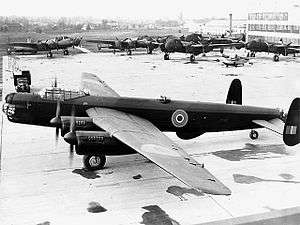
- As per Lancaster B.IV/Lincoln B.1 but built in Canada and renamed Avro Lincoln XV. One example built before order cancelled when war ended.
Operators
Surviving aircraft
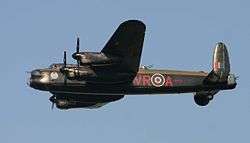
Of the 17 surviving and largely intact Lancasters known to exist, two are airworthy; one, PA474, based in Coningsby, the UK, is operated by The Battle of Britain Memorial Flight, and the other, called Vera (coded VR-A, FM213), is in Canada, operated by the Canadian Warplane Heritage Museum in Mount Hope, a suburb of Hamilton, Ontario. Another Lancaster, Just Jane, based in East Kirkby Lincolnshire Aviation Heritage Centre is able to taxi but is not airworthy.
In August 2014, the Canadian aircraft arrived in the UK for a series of joint displays with the BBMF aircraft.[46]
Specifications (Lancaster I)
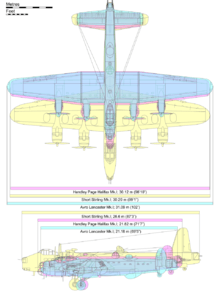
Data from Avro Aircraft since 1908[47]
General characteristics
- Crew: 7: pilot, flight engineer, navigator, bomb aimer/nose gunner, wireless operator, mid-upper and rear gunners
- Length: 69 ft 4 in (21.11 m)
- Wingspan: 102 ft 0 in (31.09 m)
- Height: 20 ft 6 in (6.25 m)
- Wing area: 1,297 sq ft (120.5 m²)
- Empty weight: 36,900 lb (16,738 kg)
- Loaded weight: 55,000 lb (24,948 kg)
- Max. takeoff weight: 68,000 lb (30,844 kg)
- Powerplant: 4 × Rolls-Royce Merlin XX liquid-cooled V12 engines, 1,280 hp (954 kW) each
Performance
- Maximum speed: 282 mph (246 knots, 454 km/h) at 63,000 lb (29,000 kg) and 13,000 ft (4,000 m) altitude [42]
- Cruise speed: 200 mph (174 knots, 322 km/h)
- Range: 2,530 mi (2,200 nmi, 4,073 km)
- Service ceiling: 21,400 ft (6,500 m) at 63,000 lb (29,000 kg)[42] ()
- Rate of climb: 720 ft/min (3.7 m/s) at 63,000 lb (29,000 kg) and 9,200 ft (2,800 m) altitude[42] ()
Armament
- Guns: 2 Browning .303 Mark II machine guns in nose turret, 2 Browning .303 Mark II machine guns in upper turret, and 4 Browning .303 Mark II machine guns in the rear turret.
- Bombs: Maximum normal bomb load of 14,000 lb (6,350 kg) or 22,000 lb (9,979 kg) Grand Slam with modifications to bomb bay.[48]
Noted Lancaster pilots and crew members
Victoria Cross awards
Many Lancaster crew members were highly decorated for actions while flying the aircraft. Amongst those who received the Victoria Cross were:
- Squadron Leader Ian Willoughby Bazalgette[49]
- Wing Commander Guy Gibson
- Warrant Officer Norman Cyril Jackson[50]
- Pilot Officer Andrew Mynarski[51]
- Squadron Leader John Dering Nettleton[52]
- Squadron Leader Robert Anthony Maurice Palmer[53]
- Flight Lieutenant William Reid
- Flight Sergeant George Thompson
- Group Captain Leonard Cheshire – most unusually he did not receive the VC for any particular act, instead it was awarded for sustained courage on over 100 bombing missions. (N.B some flown in other aircraft including the Mosquito and Mustang).
- Captain (acting Major) Edwin Swales
Other
- James Brian Tait, recommended for VC for similar reasons as Cheshire but received 3rd Bar to DSO.
- Erik Nielsen DFC, Deputy Prime Minister of Canada and Minister of National Defence, served as a lancaster pilot with 101 Sqn during WWII.
Notable appearances in media
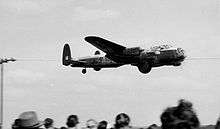
The Avro Lancaster featured prominently in the 1955 film The Dam Busters, and a number of B VII Lancasters in storage were modified to the original configuration of the B III (Special) for use on screen. The Lancaster also plays a central role in Bomber, the 1970 novel by Len Deighton about a night raid on a fictional German town by a formation of RAF bombers. It also featured in a 1989 British commercial for Carling Black Label lager which reused footage in a Dam Busters parody sequence in which a German soldier on top of a dam was catching the bombs in the manner of a football goalkeeper. The pilot of the attacking Lancaster then delivers the brand slogan: "I bet he drinks Carling Black Label!" The commercial ran for many years, frequently appearing in commercial breaks during broadcasts of both The Dam Busters and of documentaries about Operation Chastise.[54]
The Avro Lancaster was also featured in the UK TV series Pathfinders, airing in 1972 and released on DVD in 2006, concentrating on the lives of the aircrew of a fictional Pathfinder squadron during the Second World War.[55] Other films in which the Lancaster appeared include Appointment in London (1952) and The Guns of Navarone (1961).
See also
- Related development
- Avro Manchester (precursor with unsuccessful Vulture engines)
- Avro York (Transport with new fuselage)
- Avro Lancastrian (Interim VIP Transport with fairings)
- Avro Lincoln (originally designated Lancaster Mk.IV, longer wings and fuselage and improved armament)
- Avro Lincolnian (Interim VIP transport like Lancastrian but based on Lincoln)
- Avro Tudor (Airliner with Lincoln Wings and new cigar shaped fuselage)
- Avro Shackleton (Maritime patrol which used Lincoln wings with new fuselage)
- Aircraft of comparable role, configuration and era
- Boeing B-17 Flying Fortress
- Consolidated B-24 Liberator
- Focke-Wulf Fw 200
- Handley Page Halifax
- Heinkel He 177
- Messerschmitt Me 264
- Nakajima G5N
- Petlyakov Pe-8
- Piaggio P.108
- Short Stirling
- Supermarine B.12/36
- Vickers Windsor
- Related lists
References
Notes
- ↑ The "Ruhr Express" the subject of a Canadian National Film Board production Target Berlin for the Canada Carries On series, filmed in part over Berlin by NFB cameraman Grant McLean, who later became the first Western cameraman to film Mao Zedong.
- ↑ Similar problems afflicted the ventral turret in the North American B-25 Mitchell and other bombers.
- ↑ This was the same turret used on many American bombers including the Consolidated B-24 Liberator.
- ↑ "Upkeep" was referred to as a mine.
Citations
- ↑ McKinstry 2009, pp. 9–10.
- ↑ Cotter 2005, p. XIII.
- ↑ Taylor 1969, p. 314.
- 1 2 "Second World War propaganda film of "Grand Slam" in action." youtube.com. Retrieved: 3 January 2012.
- ↑ "First to South America." Flight, 20 January 1946.
- ↑ Mason 1994, pp. 324–325.
- ↑ Jackson 1990, pp. 355–356.
- ↑ "World Encyclopedia of Aero Engines – 5th edition" by Bill Gunston, Sutton Publishing, 2006, p.190
- ↑ Winchester 2005, p. 27.
- ↑ "The Design and Development of the Avro Lancaster". Manchester Branch of the Royal Aeronautical Society.
- ↑ Brown 2016.
- ↑ Bridgman 1988, pp. 105–106.
- ↑ Iveson 2009, p. 221.
- ↑ Neillands 1995, p. 109
- ↑ Stiriling, Neil. "Lancaster I/III data card." wwiiaircraftperformance.org. Retrieved: 6 August 2013.
- 1 2 3 4 5 6 7 8 9 10 11 12 13 Jacobs 1996
- 1 2 3 Franks 2000, p. 83.
- ↑ Mod 913, Avro Manufacturing Drawing Z2511
- ↑ Mod 925, shown on Avro Manufacturing Drawing X815
- ↑ Iveson 2009, p. 222.
- ↑ Hastings 1999, p. 334.
- ↑ "ROYAL AIR FORCE BOMBER COMMAND, 1942–1945. CH18371". Imperial War Museum. Retrieved 16 January 2016.
- ↑ "The Kite That Smashed Berlin". Popular Sciences, March 1944, pp. 48C–48H.
- ↑ McKinstry 2009, p. 265.
- ↑ McKinstry 2009, p. 268.
- ↑ McKinstry 2009, p. 275.
- ↑ The weight in kilograms of the "Tall Boy" and "Grand Slam" bombs differs according to source. The figures given are the most common.
- ↑ Mason, Francis K. "Lancaster: Bomb Loads." The Avro Lancaster, 1990, February 2008. Retrieved December 2011.
- ↑ Black, Henry. "Bombsights." lancaster-archive.com, 2001. Retrieved 14 November 2010.
- ↑ Chris Ward (18 June 2014). 1 Group Bomber Command: An Operational Record. Pen and Sword. pp. 117–118. ISBN 978-1-4738-3810-9.
- ↑ Galland 2005, p. 119.
- ↑ Iveson 2009, p. 82.
- ↑ Jackson 1990, p. 365.
- ↑ "Lancaster X." Canadian Aviation and Space Museum. Retrieved: 3 October 2011.
- 1 2 "The Canadian Lancasters." Bomber Command Museum. Retrieved: 3 October 2011.
- ↑ "Members' Profiles." Canada's Aviation Hall of Fame. Retrieved: 3 October 2011.
- ↑ "Lancasters After The War." Bomber Command Museum. Retrieved: 3 October 2011.
- ↑ Franks 2000, pp. 83–84.
- ↑ "Flying Gas Station In The Sky". Popular Science, January 1947.
- ↑ Avro manufacturing drawing Z2852
- ↑ Franks 2000, p. 87.
- 1 2 3 4 Mason 1998, p. 302.
- ↑ Mason 1998, p. 102.
- ↑ Holmes 2001, p. 39.
- ↑ "The Immortal Lanc" 1977, p. 157.
- ↑ "RAF BBMF to host Canadian Warplane Heritage Museum Lancaster during visit to England." RAF/MoD website News, 24 February 2014. Retrieved: 14 April 2015.
- ↑ Jackson 1990, p. 366.
- ↑ Mason 1994, p. 348.
- ↑ Richards 1995, p. 319.
- ↑ Richards 1995, pp. 304–305.
- ↑ Richards 1995, p. 310.
- ↑ Richards 1995, pp. 157–160.
- ↑ Richards 1995, pp. 346–347.
- ↑ ""Carling Black Label ad." YouTube. Retrieved: 6 August 2013.
- ↑ Alsop, Neil. "Scheduled Flight Disappears from Screen: Neil Alsop Recalls the Forgotten Heroes of TV's Pathfinders." Action TV Online. Retrieved 27 September 2009.
Bibliography
- A.P. 22062A-P.N.: Pilot's and Flight Engineer's Notes for Lancaster. Mark I – Four Merlin XX, 22 or 24 Engines. Mark III – Four Merlin 28 or 38 Engines. London: Air Ministry, May 1944. No ISBN
- Bridgman, Leonard. Jane's Fighting Aircraft of World War II. New York: Crescent Books, 1988. ISBN 0-517-67964-7.
- Brown, Eric. "Wings on my Sleeve". London: Weidenfeld and Nicholson, 2016. ISBN 978-0-7538-2209-8.
- Chant, Christopher. Lancaster: The History of Britain's Most Famous World War II Bomber. Bath, UK: Parragon, 2003. ISBN 0-7525-8769-2.
- Chorlton, Martyn. Avro Lancaster Mk I and Mk III: Database. Cudham, Kent, UK: Kelsey Publishing, 2011.
- Cotter, Jarrod. Living Lancasters: Keeping the Legend Alive. Thrupp, Stroud, UK: Sutton Publishing, 2005. ISBN 0-7509-4192-8.
- Franks, Norman. Claims to Fame: The Lancaster. London: Arms & Armour Press, 1995. ISBN 1-85409-220-0.
- Franks, Richard A. The Avro Lancaster, Manchester and Lincoln: A Comprehensive Guide for the Modeller. London: SAM Publications, 2000. ISBN 0-9533465-3-6.
- Galland, Adolf. The First and the Last: Germany's Fighter Force in WWII (Fortunes of War). Black Hawk, Colorado: Cerberus Press, 2005. ISBN 1-84145-020-0.
- Hastings, Sir Max. Bomber Command (Pan Grand Strategy Series). London: Pan Books, 1999. ISBN 978-0-330-39204-4.
- Holmes, Harry. Avro Lancaster (Combat Legend series). Shrewsbury, UK: Airlife Publishing Ltd., 2002. ISBN 1-84037-376-8.
- Holmes, Harry. Avro Lancaster. The Definitive Record 2nd Edition. Shrewsbury, UK: Airlife Publishing Ltd, 2001. ISBN 1-84037-288-5.
- "The Immortal Lanc". Wings Volume 1, Part 8, 1977. London: Orbis Publishing Ltd.
- Iveson, Tony. Lancaster: The Biography. London: Andre Deutsch Ltd, 2009. ISBN 978-0-233-00270-5.
- Jackson, A.J. Avro Aircraft since 1908, 2nd edition. London: Putnam Aeronautical Books, 1990. ISBN 0-85177-834-8.
- Jacobs, Peter. The Lancaster Story. London: Arms & Armour Press, 1996. ISBN 1-85409-456-4.
- Knott, Richard, 'Black Night for Bomber Command', Pen & Sword, 2007.
- Mackay, R.S.G. Lancaster in action. Carrollton, Texas: Squadron/Signal Publications Inc., 1982. ISBN 0-89747-130-X.
- Mason, Francis K. The British Bomber since 1914. London: Putnam, 1994. ISBN 0-85177-861-5.
- Mason, Tim. The Secret Years: Flight Testing at Boscombe Down 1939–1945. Manchester, UK: Hikoki, 1998. ISBN 0-9519899-9-5.
- McKinstry, Leo. Lancaster: the Second World War's Greatest Bomber. London: John Murray, 2009. ISBN 978-0-7195-2353-3.
- Moyes, Philip J.R. Avro Lancaster I & II. Kidlington, Oxford, UK: Vintage Aviation Publications Ltd., 1979. ISBN 0-905469-65-8.
- Neillands, Robin. "The Conquest of the Reich: D-Day to VE Day--A Soldiers' History". New York: NYU Press, 1995. ISBN 0-814757-81-2
- Page, Bette. Mynarski's Lanc: The Story of Two Famous Canadian Lancaster Bombers KB726 & FM213. Erin, Ontario, Canada: Boston Mills Press, 1989. ISBN 1-55046-006-4.
- Richards, Denis. The Hardest Victory: RAF Bomber Command in the Second World War. London: Coronet, 1995. ISBN 0-340-61720-9.
- Robertson, Bruce. Lancaster: The Story of a Famous Bomber. Watford, Hertfordshire, UK: Argus Books Ltd., Fifth impression 1977, First impression 1964. ISBN 0-900435-10-0.
- Sweetman, Bill. Avro Lancaster. London: Jane's Publishing Company Ltd., 1982. ISBN 0-7106-0132-8.
- Tarring, Trevor and Mark Joseland. Archie Frazer-Nash ... Engineer. London: The Frazer Nash Archives, 2011. ISBN 978-0-9570351-0-2.
- Taylor, John W. R. "Avro Lancaster". Combat Aircraft of the World from 1909 to the present. New York: G.P. Putnam's Sons, 1969. ISBN 0-425-03633-2.
- Winchester, Jim. "Avro Lancaster". Aircraft of World War II: The Aviation Factfile. Kent, UK: Grange Books plc, 2004. ISBN 1-84013-639-1.
Further reading
- Benedetto, Fernando (2009). Núñez Padin, Jorge Felix, ed. Avro Lancaster, Lancastrian & Lincoln. Serie Fuerza Aérea (in Spanish). 17. Bahía Blanca, Argentina: Fuerzas Aeronavales. ISBN 978-987-1682-00-3.
External links
| Wikimedia Commons has media related to Avro Lancaster. |
- The Lancaster Archive
- Surviving Birmingham and Manchester made Avro Lancasters
- The Lancaster's electronic equipment
- Avro 683 Lancaster
- "The Avro Lancaster" a 1942 Flight article
- Virtual tour of "Just Jane" at Lincolnshire Aviation Heritage Centre
- "An Avro Lancaster starts up, taxis out, takes off and does a flypast" on YouTube
- "Sky Giant (1942)" on YouTube



